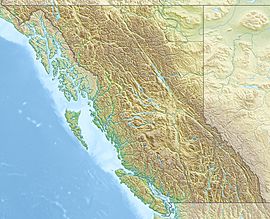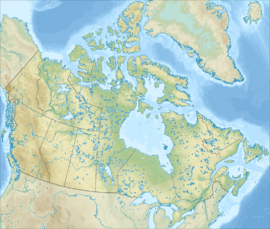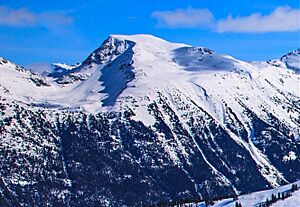Decker Mountain facts for kids
Quick facts for kids Decker Mountain |
|
|---|---|

Decker Mountain as seen from the Whistler Mountain ski area
|
|
| Highest point | |
| Elevation | 2,421 m (7,943 ft) |
| Prominence | 158 m (518 ft) |
| Parent peak | Mount Trorey |
| Listing | Mountains of British Columbia |
| Geography | |
| Location | Garibaldi Provincial Park British Columbia, Canada |
| Parent range | Spearhead Range Garibaldi Ranges Coast Ranges |
| Topo map | NTS 92J/02 |
| Climbing | |
| First ascent | 1954 VOC party |
| Easiest route | Eastern slope |
Decker Mountain is a tall, flat-topped mountain in British Columbia, Canada. It's part of the Coast Mountains and found inside Garibaldi Provincial Park. It stands 2,421-metre (7,943-foot) high.
This mountain belongs to the Spearhead Range, which is a group of mountains within the larger Garibaldi Ranges. It is located about 9 km (6 mi) southeast of Whistler, a famous ski town. Water from the south side of Decker Mountain flows into Fitzsimmons Creek. Also, meltwater from the Decker Glacier on the northeast side drains into Wedge Creek.
Decker Mountain is often climbed as part of the Spearhead Traverse, a popular multi-day hiking and skiing route. The first ascent (first time someone successfully climbed to the top) of the mountain was in 1954. This climb was done by a group from the Varsity Outdoor Club of the University of British Columbia.
The mountain's name, Decker Mountain, describes its shape. It looks like it has two flat layers or "decks" on top. The "er" at the end was added to make the name sound better. The name was officially accepted on August 27, 1965. This happened after Dick Culbert, who wrote a guide for climbing in the Coastal Ranges of British Columbia, suggested it to the Geographical Names Board of Canada.
Weather at Decker Mountain
Decker Mountain is in a marine west coast climate zone. This means it gets a lot of rain and snow. Most weather fronts, which are like big air masses, come from the Pacific Ocean. They travel east towards the Coast Mountains. When they hit the mountains, the air is forced to rise. This causes the air to cool down and drop its moisture as rain or snow. This process is called Orographic lift.
Because of this, the Coast Mountains get a lot of precipitation, especially snowfall in winter. Temperatures can get very cold, sometimes dropping below −20 °C. With the wind, it can feel even colder, below −30 °C. The best time to climb Decker Mountain is usually from July to September because the weather is more favorable then.
Climbing Routes
People can climb Decker Mountain using different paths. Here are some of the known climbing routes:
- East Side
- Southwest Face
- Northwest Face
- Decker Glacier




